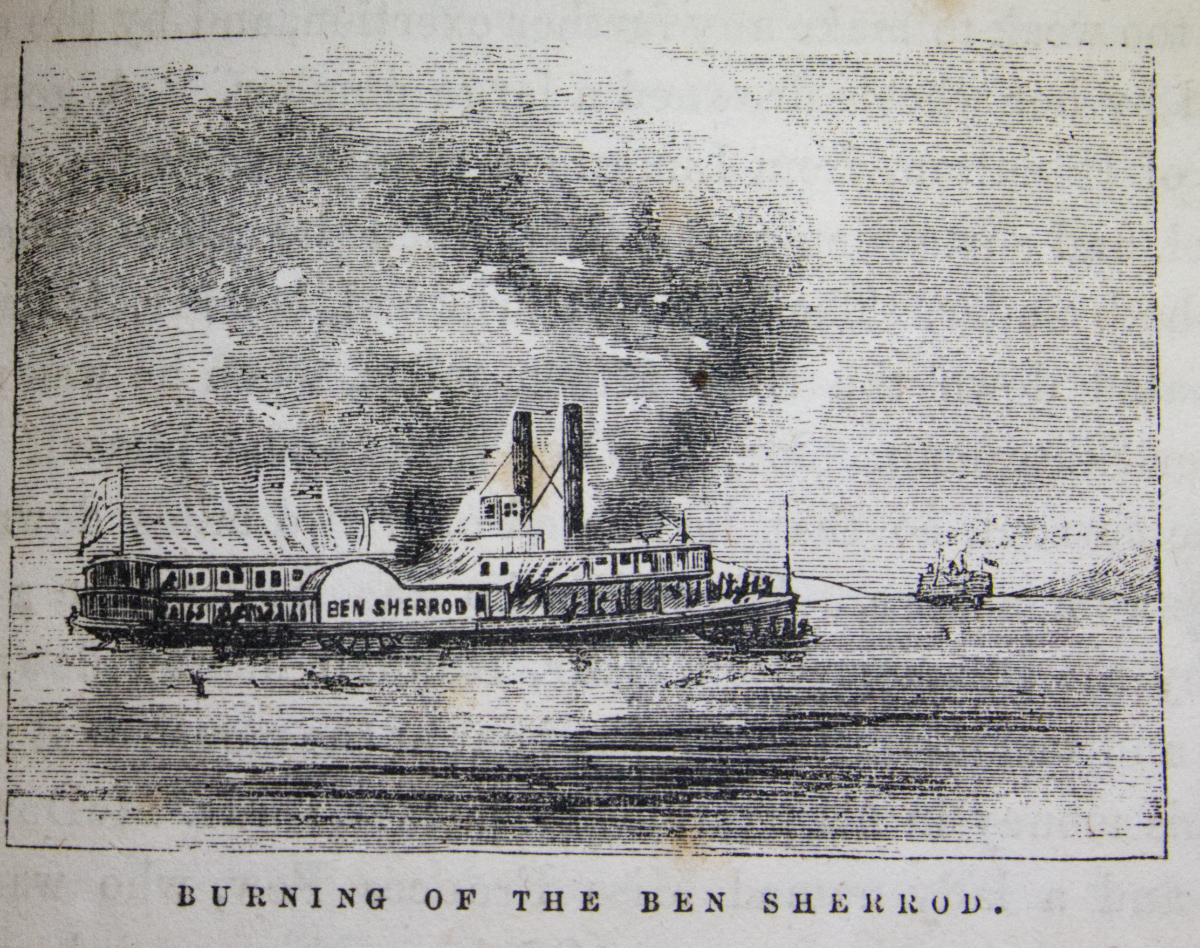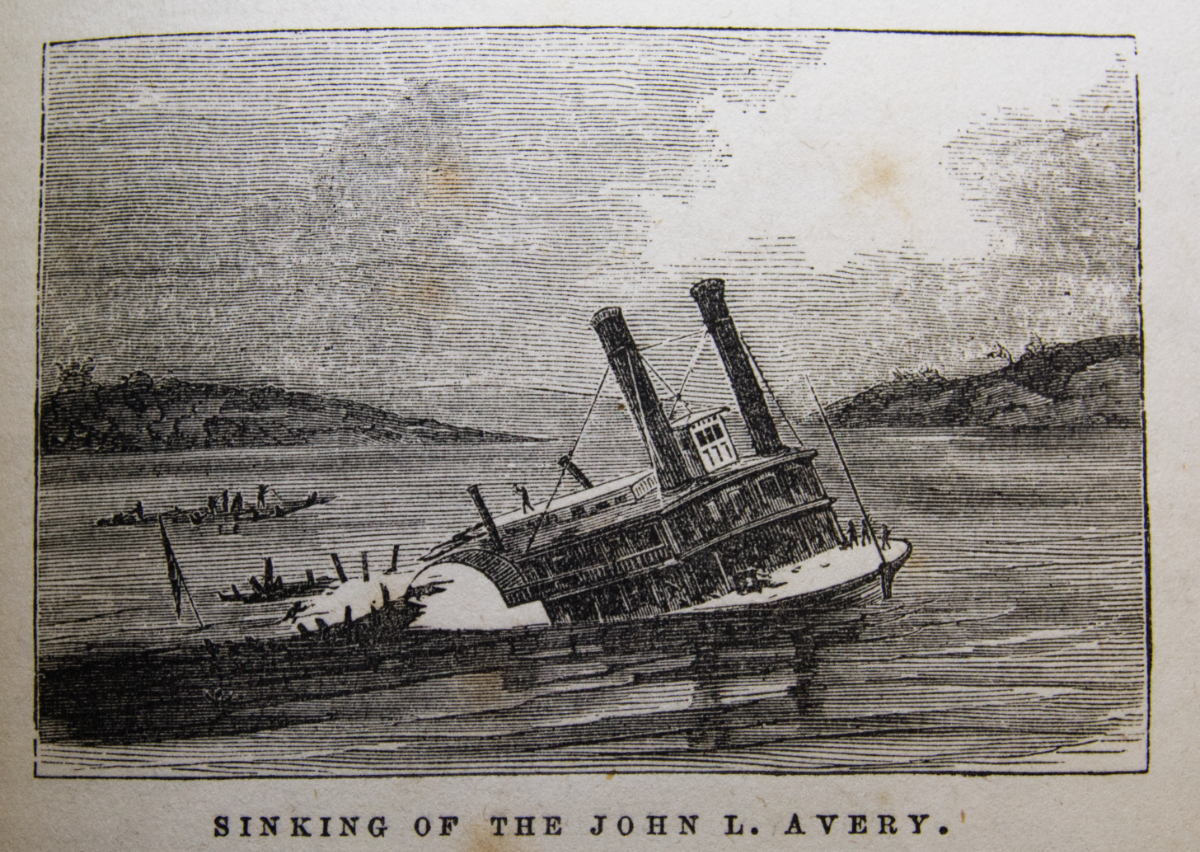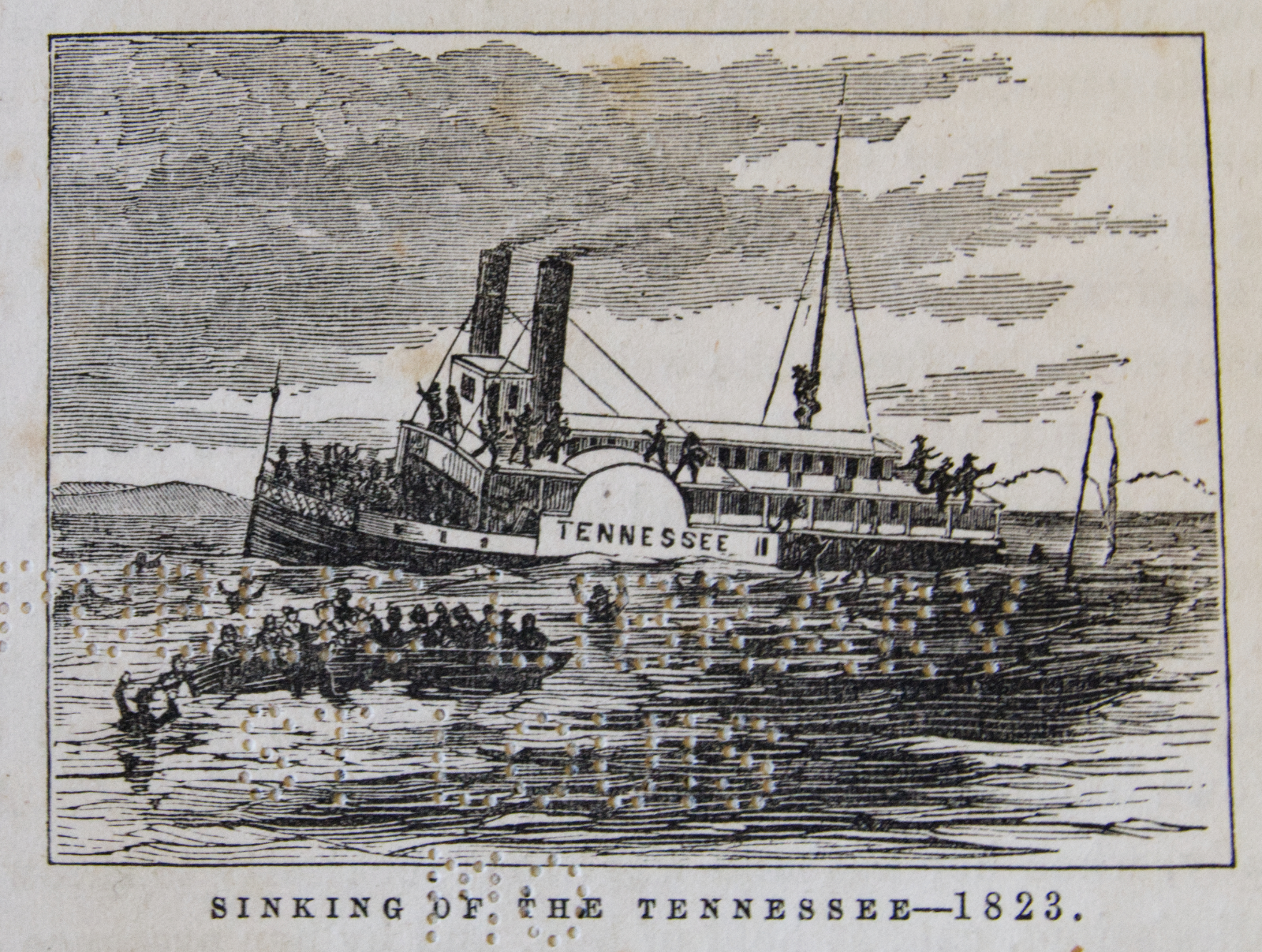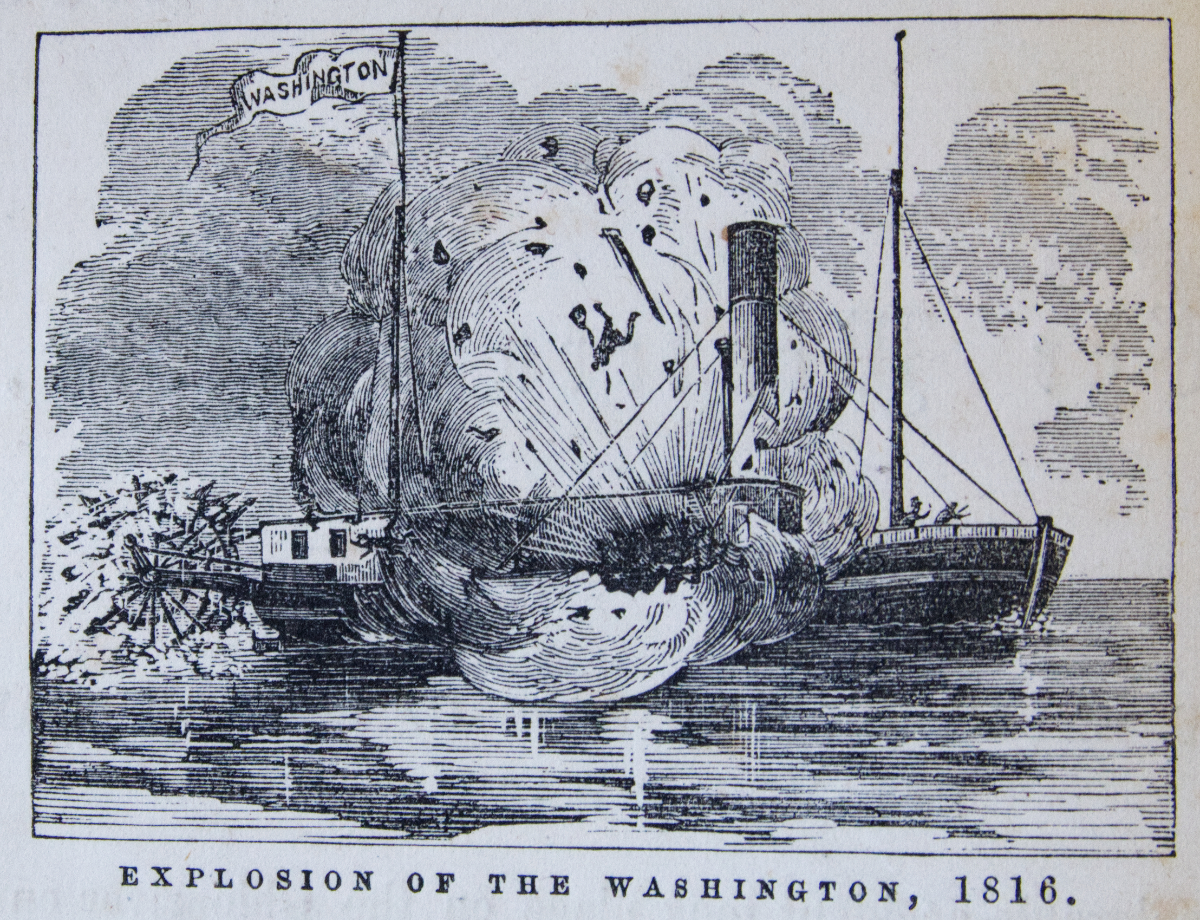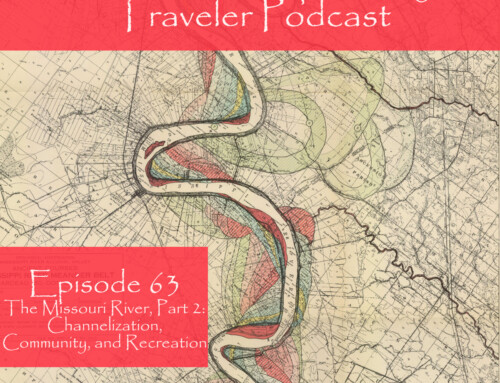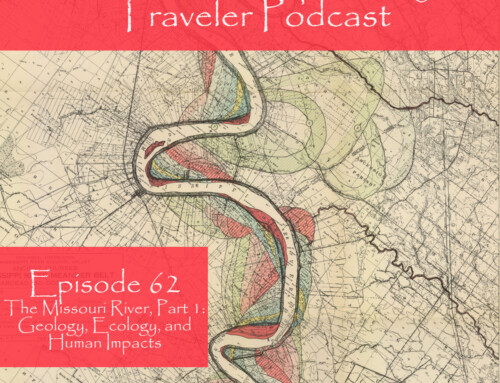Steamboats revolutionized travel, dramatically shortening the time it took to get from place to place. When we think of the peak period of steamboat travel, we often picture images of tall boats with lacy trim and passengers dressed in finery relaxing in elegant lounges. But those steamboats were also prone to catastrophic failure that even the well-heeled passengers couldn’t escape. In this episode, I describe the threats that steamboat passengers and crew faced every day: the dangers of floating debris in the river, worries about boat-engulfing fires, and the terror of a boiler explosion. I share a few first-hand accounts from survivors of steamboat disasters and describe a boiler explosion inflicted terrible suffering on one of our most beloved personalities, Mark Twain.
Show Notes
For even more stories about steamboat wrecks, look for Lloyd’s steamboat directory, and disasters on the western waters. You can download a copy of the whole book from the Library of Congress.
Support the Show
If you are enjoying the podcast, please consider showing your support by making a one-time contribution or by supporting as a regular contributor through Patreon. Every dollar you contribute makes it possible for me to continue sharing stories about America’s Greatest River.
Don’t want to deal with Patreon? No worries. You can show some love by buying me a coffee (which I drink a lot of!). Just click on the link below.
Transcript
Mon, Oct 07, 2024 1:55PM • 43:08
SUMMARY KEYWORDS
steamboat disasters, Mississippi River, fragile boats, snag collisions, fire hazards, boiler explosions, steamboat technology, Robert Fulton, steamboat innovations, steamboat accidents, steamboat safety, steamboat history, steamboat revolution, steamboat challenges, steamboat tragedies
SPEAKERS
Dean Klinkenberg
Dean Klinkenberg 00:00
It was more than three weeks after the occurrence, before I ever shed a tear. All the fountains of sympathy had been dried up, and my heart was a stone. As I lay on my bed the 24th day after, tears, salt tears came to my relief, and I felt the loss of my sisters and brother more deeply than ever, Peace be to their spirits. They found a watery grave. Welcome to the Mississippi Valley Traveler Podcast. I’m Dean Klinkenberg, and I’ve been exploring the deep history and rich culture of the people and places along America’s greatest river, the Mississippi, since 2007 join me as I go deep into the characters and places along the river, and occasionally wander into other stories from the Midwest and other rivers. Read the episode show notes and get more information on the Mississippi at MississippiValleyTraveler.com. Let’s get going. Welcome to Episode 50 of the Mississippi Valley Traveler podcast. Can’t Believe it’s episode 50 already, so feels like an important landmark. So I thought, why not dive deep into the dark history of steamboat travel to celebrate 50 episodes and hey, it’s close to Halloween as well, so maybe it’s good timing for that. In this episode, I’m going to give you kind of a quick history of steamboat technology and just a couple of notes on how it revolutionized travel in the United States. Then we’re going to get right into the problems with those steamboats. Namely, they turned out to be quite fragile. In fact, uncomfortably fragile if you were someone who was paying for a ride on one of them. Those boats tended to run into debris in the river, mostly trees or parts of trees known as snags. Those boats could catch on fire very easily and go up in a giant ball of flame in a matter of minutes, and sometimes the boilers that powered those boats, blew up. That would be you don’t you didn’t want to be on one of those boats when the boilers blew up. So I’m going to tell you about each of those and give you some stories that we know about each of those kinds of disasters on the river. You can read more about the steamboat disasters and other disasters and tragedies in my book, “Mississippi River Mayhem”, which you can find wherever books are sold. Thanks. If you’re a Patreon supporter, thank you. Thank you. I deeply appreciate your support, and you keep me and the podcast going. If Patreon isn’t your thing, you can just buy me a coffee, and I drink plenty of that. It’s good to have somebody help me sustain my caffeine habit. If you want to know how to do either one of those things, go to MississippiValleyTraveler.com/podcast and there you’ll find out how to join the Patreon community, where for as little as $1 a month, you can get early access to these podcasts, or you can just buy me a coffee show notes for each episode and a full listing of all 49 previous episodes are at that same address, MississippiValleyTraveler.com/podcast, and now on with the show. The New Orleans, the first steamboat to ply the Mississippi River worked the lower half of the river from 1812 until July 14 of 1814 when an overnight foot and a half drop in the river impaled the boat on a tree stump, destroying it. Its active life of three years was about average for a steamboat, and its death at the hands of a snag typical. Even though steamboats proved to be uncomfortably fragile, they ushered in a transportation revolution. Steamboat innovators like John Fitch and James Rumsey may not have imagined how radically the boats would transform American life, but Robert Fulton certainly did. Fitch and Rumsey engaged in a bitter struggle to build and operate the first steam powered boat. They weren’t the first to tinker with the idea, though, on July 15, 1783, Frenchman Jou Froid d’Abbans successfully powered a boat with a steam engine on the river Sohn at Lyon. His boat moved back and forth for 15 minutes before it shook to pieces. In the United States, Fitch’s boat passed the first tests on August 22 1787, his steam powered boat made a brief run on the Delaware River in front of a crowd that included members of the Continental Convention. Just three months later, Rumsey had his first successful trial run on the Potomac River. Three years later, Fitch’s designs had advanced enough to power a ferry that made regular trips between Philadelphia and Trenton, New Jersey. Still, the timing just wasn’t right. People were deeply skeptical of the technology. So neither man could line up investors. Their boats ended up in the trash heap of history. Rumsey died broke in 1792 he was just 49 years old. Fitch didn’t fare any better. He gave up on designing steamboats and moved to Kentucky in late 1795. In the last few months of his life, despondent and alone, he drank himself to the grave. He died in 1798. Robert Fulton did not invent steam powered boats, but he made the technology work reliably. He combined the best ideas from other inventors and put them together to fashion a stable engine and a profitable business. Engineering wasn’t his first career choice, as it turned out. He wanted to be an artist, a painter, and even moved to England in search of a mentor. When painting didn’t work out. He shift his he shifted his interest to engineering that turned out to be a good choice. When he lived in Paris, he met Robert Livingston, the US ambassador to France at the time, and the two formed a partnership to develop steamboat technology. They were a formidable team. It took a few years to pull off, but their combined resources and expertise culminated in the construction of the first commercially successful boat, the North River Steamboat. The boat made its maiden voyage on August 17, 1807 with a trip up the Hudson River from New York City to Albany and back. Just four years later, Nicholas Roosevelt piloted another of their boats, the New Orleans, from Pittsburgh to New Orleans, getting steamboat technology to the place that Fulton had eyed from the very beginning, the Mississippi River. Steamboats were well suited to navigate the Mississippi. Their basic design a powerful engine that turned a paddle wheel and a long, flat hull that didn’t sink deep into the water worked well in the shifting currents and depths of the Mississippi. Decks were stacked, one on top of another, like layers of a cake. Cargo was stacked on the decks. Even better, the wood needed for construction and for feeding the boilers was plentiful along the Mississippi. Unfortunately, the primary advantages of steamboats also made them prone to catastrophic failure. Driftwood easily punctured shallow hulls, wood holes and decks were kindling for fires, and those powerful boilers that pushed the boats forward could be quite temperamental. A failure on any of these fronts, usually ended in tragedy. Before the Civil War, nearly a third of steamboats reached their end because of an accident. Imagine if today, 1/3 of all planes ended their lives in an accident. It’s hard to hard to imagine that, isn’t it. Of all the causes that took them down. The most common and perhaps the easiest to avoid, was hitting a snag. Basically, trees and logs floating in the water. Snags caused about half of all steamboat accidents. When steamboats first began running the Mississippi, river travelers could be forgiven if they thought that floating trees and limbs were as numerous as fish. Some of that debris floated on the surface, while other bits lodged into a bank or the bottom of the river. Those snags so dangerous to boats, inspired rivermen to name the more common varieties. Sawyers moved back and forth in the current. Preachers popped up and down in the water. Planters lodged firmly in the river’s bottom. Sleepers lurked just below the surface. The pilot and crew had to keep a careful eye on the river, looking for Telltale changes in the water’s surface that gave away the presence of snags. Still, they were so plentiful, they were virtually impossible to avoid all the time. When a steamboat collided with a snag, the resulting damage could be anything from a small, easily plugged hole to a death blow. If a snag fully penetrated the hull, a boat was typically doomed. Most sank in just a couple of minutes. That was the case for the Glendy Burke, a steamboat popularized in the 19th century song penned by Stephen Foster that opens with a line “The Glendy Burke is a mighty fast boat.” And while it may have indeed been swift, that speed was no help when it collided with one of those mighty snags. On the afternoon of May 24 1855, it. hit driftwood near Cairo, Illinois, and sunk in about two minutes. The boat settled on a sandbar with its bow in eight feet of water and its stern in 18 feet. Everyone on board survived, though, and the debris of the Glendy Burke, which proved too difficult to remove, became yet another navigation hazard. As late as October 1891 pieces of the Glendy Burke were poking holes in passing boats. While hitting a snag was often fatal for a boat, the passengers usually survived, especially if the accident happened in shallow water or near shore, as was the case with the Glendy Burke. If, however, the pilot couldn’t get the boat close to shore quickly, the consequences could be tragic. In February 1823, the Tennessee hit a snag near Natchez, Mississippi, late at night during a heavy storm. The snag, a large tree ripped a big hole in the hull. As the boat sank, people panicked and jumped into the river. Some pulled off a door or found a piece of debris to use as a raft. Others drowned, though, as the cold water sapped their strength. That accident killed about 60 people, one of the first major snag related disasters on the Mississippi. Many more followed. The Nick Biddle went down 45 miles north of Vicksburg on July 25, 1837. 10 deck passengers died. The Eliza sank near the mouth of the Ohio River on October 8, 1842 killing 40 people. The Keokuk crashed near st Genevieve island on August 29 1844 killing a cabin passenger and a dozen deck passengers. The DeWitt Clinton sunk near Memphis on January 25, 1852; 40 people died, including 16 enslaved Blacks. The suddenness of a snag related accident, the shock of the impact, disoriented passengers and crew. Many passengers told harrowing stories about how they survived these harsh conditions. One passenger remembered only as Mrs. Seymour was asleep in her cabin on the John L Avery when it struck a large tree on March 9, 1854, within seconds of the collision, her cabin flooded with river water. One of the boat’s waiters, a man named John Anderson, pulled her to safety, but because of the suddenness of the accident, she lost $900 in cash, which was a lot of money then, and a completed manuscript that she’d stashed in a pillow. And man, I feel that pain. The Avery, just a year old, had apparently been racing the Sultana to Louisville. The Mississippi swelled with its light winter rise and drifting trees and limbs clogged the surface when the Avery struck one of them. After the collision, the pilot turned the boat towards shore, but his effort was futile. The hole broke off from the cabin and sank in 60 feet of water. Cabin passengers rushed to the hurricane deck, where some of them, including the captain, pulled them up through the boat skylights. Mrs. Seymour was among those who found safety on the hurricane deck, which gave her a vantage point to witness the tragedy as it unfolded. She recalled “the water at first was dotted with human heads sinking and rising and then sinking to rise no more.” At one point she saw a woman who had just been rescued slide back into the water and disappear. She recalled “In a faint but earnest tone. I heard a female voice say, Oh, William, do save her. On directing my gaze to the place from whence the voice came I saw a woman sinking in the river at the same time a child’s voice exclaimed, O, mother, he cannot save me. I saw her fair hair all wet fall back from her young face as her little arms loosened their grasp on the neck of her brother and the mother and her two children sank together.” A few years before the Avery disaster on January 3, 1844 the Shepherdess was nearing St Louis when deep in the night it hit a snag. Water filled the boat quickly, surprising even the crew. Steamboat disaster chronicler James Lloyd wrote, As soon as the shock was felt on board, one of the pilots attempted to descend into the hold for the purpose of examining the leak, but he had scarcely entered when the rush of water drove him back. In just a couple of minutes, water completely covered the lower deck. The captain sought to reassure as many passengers as he could, most of whom had been asleep when the boat rammed into the tree. He visited the women’s cabins and told them that the boat would be just fine. After that, he walked back to his post, then disappeared forever. The river probably swept him away. A few passengers got to the yawl and paddled it to shore with a broom. Cabin passengers climbed the hurricane deck for safety. As the current dragged the boat down river, it hit another snag, and the boat twisted in circles. The river then pushed the powerless boat into a bluff, which knocked the cabin off the hull. The hull sank, but the cabin floated further down river and lodged on a sandbar where rescuers later found the few survivors. At least one passenger went to great lengths to save lives. Kentucky native Robert Bullock ran through the cabin and searched the staterooms for survivors, reportedly rescuing several women and children. One person he saved required a little extra help. One account of his efforts reported, quote, his last effort was to rescue Colonel wWoods, quote, Ohio, fat girl, unquote, who happened to be on board. Her weight was 440 pounds, but with the assistance of several persons on the hurricane deck, he succeeded in raising her to that place of security. Bullock later fell off the boat, probably when it hit that second snag, but swam to shore, where he saved a couple more lives. When he emerged from the river, he found two shivering survivors. He sat with them and kept it and kept them from passing out and possibly into a coma until they were rescued and taken to nearby Cahokia, Illinois to warm up. While Bullock went to great lengths to save lives, people of the day did not value every life lost equally. One account of the disaster noted quote, Mr. Muir of Virginia and his brother were on board with their mother and nine of their slaves, with the exception of seven of the slaves, all of these persons were saved. The deaths of the seven enslaved Blacks were merely incidental. Their names not noted. Enslaved Blacks were confined to the deck, which was the worst place to be when this steamboat hit a snag, cargo was stacked everywhere, which sometimes blocked the quickest paths off the boat. The deck was also the cheapest part of the boat to travel on, if you weren’t enslaved. Deck passage got you on the boat, but no specific spot, so deck passengers scrambled to claim space among the cargo and deck crew. It was a noisy, loud, uncomfortably and smelly way to travel, but it was cheap. Boats regularly pushed the limits by cramming the deck with low fare passengers. It wasn’t unusual for a steamboat to carry five times as many people on deck as in the cabins, because deck passage was so cheap and a much quicker way to travel than over land. The deck passengers were often immigrants. So when a boat went down, they were over represented among the victims. 20 German immigrants died on the Star Spangled Banner, for example.40 Germans died when the Caspian sank. Over 120 people died on the John Adams, most of them German and Irish immigrants, and at least a third of the dead on the John L Avery were, as one account described, quote, undocumented immigrants, all Irish. We’ll never know how many people actually died in these accidents. The steamboat companies didn’t always record the names of deck passengers on the ship’s manifest. Death tolls for the John L Avery, for example, range from 30 up to 90. That’s pretty big range. That was just one reality of the day. After exhausting all their money to come to the United States on long, uncomfortable ocean crossing ships, these immigrants boarded a Mississippi River steamboat for the last leg of their journey to a new life, but instead died anonymously in the depths of the muddy Mississippi. Hey, Dean Klinkenberg here, interrupting myself, just wanted to remind you that if you’d like to know more about the Mississippi River, check out my books. I write the Mississippi Valley Traveler guide books for people who want to get to know the Mississippi better. I also write the Frank Dodge mystery series that is set in places along the Mississippi. My newest book, ‘The Wild Mississippi,’ goes deep into the world of Old Man River. Learn about the varied and complex ecosystem supported by the Mississippi, the plant and animal life that depends on them, and where you can go to experience at all, find any of these wherever books are sold. Fires were another persistent danger to steamboats, the third most common cause of accidents. It’s amazing that more boats didn’t burn up, considering that they were giant wooden boxes powered by huge furnace surrounded by combustible materials like bales of cotton and other and wood. What could possibly go wrong with all that? Most steamboats burned wood for fuel to fuel their boilers, but because they had little extra space to carry all that wood, they’d stop up to twice a day to what was known as “wooding up.” Is just stopping to buy cords of wood from shoreline entrepreneurs. Boats typically only burn coal as fuel in areas where it was cheap and easy to buy, such as along parts of the Ohio River or Southern Illinois. While trees were abundant in the early days of steamboating, they were a finite resource, and over time, those dense riparian forests disappeared. After a boat resupplied with wood, the crew stacked it in the engine room near the boilers so would be easy to feed into the machines, while most engine room crews made sure that those combustible stacks of wood burnt inside the boiler only, they weren’t always attentive enough. It only took one misplaced pile of wood or random spark to ignite a dangerous fire, like with many dangers of steamboat travel, the industry and travelers adopted a live and let die attitude toward fires and fire prevention. The French economist and political writer Michael Chevalier traveled around North America in the 1830s. He found this attitude rather distressing. He wrote, quote, there have been many accidents by fire in the steamers, and many persons have perished this way. Although the river is not very wide, the Americans show a singular indifference in regard to fires, not only in the steamboats, but also in their houses, they smoke without the least concern in the midst of the half open cotton bales with which a boat is loaded, they ship gunpowder with no more precaution than if it were so much maize or salt pork, and leave objects packed up in straw right In the torrent of sparks that issue from the chimneys. Inattention and maybe drunkenness doomed the Ben Sherrod to the bottom of the Mississippi when cords of wood placed near the boilers ignited. By the time the crew members noticed it, many of them, someone said later, had been drinking liberally from a barrel of whiskey, the fire had grown too large to stop. The Ben Sherrod had left New Orleans for Louisville, Kentucky, fully loaded with cargo and passengers, even several horses that were stabled in the boat’s forecastle. Just a year old, the boat was not among the most luxurious steamers on the river. By early May, though peak steamboat season had passed, so folks looking for a ride up river didn’t have many choices. The boat stopped at Fort Adams, Mississippi, then found itself in a race to Natchez with the Prairie. Passengers goaded Captain Castleman to show up the Prairie, and he obliged. He ordered the engine crew to run at full steam, and reputedly opened a barrel of whiskey to keep the night crew happy. Then he went to bed. The firemen fed the boilers through the night, adding in pine knots and resin so the fire would burn even hotter. The piles of wood near the boilers occasionally caught a spark, but the crew quickly extinguished them. Early in the morning on May 8, 1837, though not long after the boat had passed the Homochittoh River, a pile of wood ignited and burned beyond the point of no return. Much of the deck crew panicked and ran for the yawl. The captain, awakened by the ruckus, ordered them to stop. They ignored him, and soon got in the yawl and lowered it in their haste or inexperience, though one end of the yawl dropped much faster than the other end, and the men fell into the Mississippi where they drowned. The fire burned the tiller rope so the pilot could no longer steer the boat. The current kept the Ben Sherrod far from shore as the fire spread quickly. Passengers didn’t have time to get dressed or grab belongings. Everyone was terrified. Some passengers, maybe those who had tried to salvage what they could, died in their staterooms. The horses in the forecastle stomped and neighed, but they had nowhere to go. All of them perished. 10 women jumped in the river to escape the flames, but only two survived. A couple of boats, the Columbus and the Statesmen, raced over and pulled people out of the water. The Prairie, though, which had been near the Ben Sherrod, when interrupted in flames, didn’t turn back, even though the crew must have seen the boat on fire, one woman had jumped in the river with her infant child after witnessing her husband being consumed by flames. She sank onto a plank and floated to within 40 yards of the Columbus when the crew threw a rope to her, though she lost all strength and sank into the river, taking her child with her. Another steamer, the Alton, cruised near the disaster site, but didn’t slow down waves. The boat kicked up swamped passengers who had been holding on. Many of them died. It wasn’t clear if the Alton’s crew hadn’t heard the survivor’s cries for help, or if they just didn’t care. It. Another person who entered the disaster area was far more interested in making money than saving lives. He paddled out from shore in a canoe, but refused to help anyone who wouldn’t promise to pay him as the wreckage of the Ben Sherrod floated helplessly downriver, survivors heard several explosions. Barrels of whiskey apparently burst first, followed by the boilers in a final and dramatic burst, barrels of gunpowder blew up and showered the sky with fireworks. Nothing was left of the Ben Sherrod after that. Again, we’ll never know just how many people died. The ship’s logs burned up so there were no surviving records of who was on board. One crew member estimated that 78 people had booked passage on the deck, but only six survived. Captain Castleman and his wife survived, but their three children and the captain’s father all perished among the crew. The fire claimed a clerk, a pilot, a mate, all the chambermaids and all but two of the 35 enslaved blacks on board. The best guess is that 120 people died. Even those who survived lost almost everything they had. One man lost, lost $20,000 in cash to the fire. Another $38,000. An unnamed survivor who lost three siblings but saved a stranger’s infant child by swimming with it to shore, later reflected on the experience, quote, it was more than three weeks after the occurrence, before I ever shed a tear, all the fountains of sympathy had been dried up, and my heart was a stone as I lay in my bed the 24th day after tears, salt tears came to my relief, and I felt the loss of my sisters and brother more deeply than ever. Peace be to their spirits. They found a watery grave. He insisted that the tragedy was ultimately avoidable. He wrote, quote, a little presence of mine and a set of men unintoxicated, could have saved the boat. The pilot who died, a man named Davis, had a prescient conversation with another pilot before leaving New Orleans. They were talking about the recent fire on the steamer St Martinsville. Davis said, quote, if ever I should be on a boat that takes fire and don’t save passengers, it will be because the tiller ropes burn, or I perish in the flames. He lived up to his words, those ropes did indeed burn, but he stayed at his post, and he went down with the boat Boilers, those hulking machines that drove the steamboats that revolutionized travel in America, generated power and produced peril. Steamboats needed those huge boilers to create the energy to push a boat against the current of a big river. The high pressure boilers that eventually became standard on steamboats were not only lighter than the early low pressure systems, but also more powerful, cheaper and easier to fix on the fly. Those high pressure boilers, though, came with one unfortunate downside, sometimes they blew up. Keeping boilers stable was more art than science. Pressure gages were often unreliable, especially for the first generation of boilers. Still, pilots were encouraged, rewarded, even to run fast to beat competitors, which required keeping those boilers full of steam. This was not a good combination. Boilers regularly built up too much pressure and exploded in a dramatic and catastrophic burst, which blew through the wooden hull and superstructure and sprayed scalding water everywhere. Boiler explosions accounted for about a third of steamboat accidents, but most of the fatalities. During the golden days of steamboat travel, 1000s of people died when boilers exploded, and it didn’t matter who you were, how much money you had, or how brilliant you might be. A boiler explosion, in fact, nearly put a premature end to the life of one of the early steamboat entrepreneurs, Henry Shreve, the son of a revolutionary war colonel who served with George Washington, had ambitions to transform river travel with fast, efficient steamboats that could navigate big rivers with ease. In 1814 Shreve piloted the Enterprise to New Orleans to bring supplies, weapons and ammunition to General Andrew Jackson’s defense against the British attack. Shreve’s trip, though, violated a monopoly granted to Robert Fulton and Robert Livingston. In 1811 the governor of Orleans territory, William Clairborne, had awarded them exclusive rights to operate steam powered boats on the Mississippi and Louisiana. Shreve evaded attempts to seize his boat, then piloted the enterprise back up the Mississippi and Ohio. The success of the trip not only showed off his piloting skills, but also proved the potential of boiler powered steamboats to run against the current of the big rivers. Shreve recognized limitation of the Enterprise technology, though, so in 1815 when he was 29 he built the Washington. One of the innovations was designing a hull that floated higher so the boat could run in shallower water. Shreve built one of the first high pressure boilers and ditched the heavy condenser that had been standard prior to that. He also created a method to draw in water from the river to cool his high pressure boiler. Shreve had high hopes that the new boat would help him crush Fulton’s monopoly on the Mississippi. Shreve guided the Washington on its maiden voyage on June 4, 1816. The boat left from the Ohio river port of wheeling West Virginia with 21 passengers. A few lucky guests stayed in one of the three private rooms in the main cabin where they could socialize in the spacious salon. The rest slept in one of the 20 berths in a common room. Five days into the trip, Shreve took the boat out for a test run near Marietta, Ohio. As the boat drifted away from shore, Shreve signaled for the engineer to fire up the boiler as the engineer fed wood into the furnace, a safety valve failed and the boiler exploded. Eight people died immediately, while five others were mortally wounded. In a split second, a languid cruise transformed into a scene of grisly horror. Steamboat historian James Lloyd wrote about this event, quote, the deck was strewn with mangled and writhing human beings uttering screams and groans of intense suffering, some more fortunate than their companions lay still in the embrace of death. Among the wounded six or eight, under the influence of their maddening torments, had torn off their clothes to which the entire skin of their limbs or bodies adhered, the eyes of others had been put out and their faces were changed to an undistinguishable mass of flesh by the scalding water. But the greatest sufferers, apparently, were those who had been internally injured by inhaling the scalding steam, the effect of which on the lungs as agonizing beyond all the powers of imagination to conceive. The whole scene was too horrible for description, and it made an impression on the minds of those who witnessed it, which could never be obliterated. The first boiler explosion of the steamboat era killed 17 of the 21 passengers. Shreve survived, but was badly injured. The explosion damaged the Washington but didn’t destroy it. So Shreve had it towed back to port for repairs. In early fall, he relaunched it, successfully navigating the Ohio and Mississippi Rivers. He arrived in New Orleans on October 7 with his boat intact. The monopoly tried unsuccessfully to seize the boat in New Orleans, and Shreve made a triumphant return upriver. A short time later, the courts invalidated the monopoly, and Shreve would go on to great success as one of the most esteemed rivermen of the era. Shreveport, Louisiana, for example, was named in his honor. Even the most famous riverman of the 19th century, Mark Twain, suffered a crippling loss from a boiler explosion. In 1858 when the 22 year old was still going by his birth name, Samuel Clemens, he lost his younger brother Henry to a boiler explosion on the steamboat Pennsylvania. The disaster might have taken both their lives if young Samuel hadn’t had a short fuse. Samuel and Henry had been working on the Pennsylvania just a few days before the boat went down. Samuel had a gig as a steersman for the trip from St Louis to New Orleans, part of the lengthy apprenticeship he completed to become a full fledged river pilot. Henry was a mud clerk, a job that didn’t come with a salary, but one that could maybe someday lead to a promotion to a position that paid. En route to New Orleans, Henry relayed a message to the pilot, William Brown, that the Pennsylvania would need to make an unplanned stop at an approaching landing. Twain, in his typically subtle matter, described Brown as, quote, a horse faced ignorant, stingy, malicious, snarling, fault hunting moat magnifying tyrant. According to Twain, Brown was also hard of hearing. When the boat floated past, the landing, Captain Klinefelter went to the pilot house to talk to the pilot. Brown feigned ignorance about the stop, but Samuel, who had been in the pilot house when Henry passed on the instructions, backed up his brother’s story. Siding with a mud clerk over a pilot broke a professional code of conduct, though, so Brown was angry with the Clemens brothers. As Henry left the pilot house, Brown chased after him while carrying a sizable chunk of coal. Samuel assumed Brown was going to try to crush Henry’s head with that coal, so he got in between them to protect his brother, then flattened Brown, smacking him with a stool. At that moment, the long and torturous history that Samuel had endured with Brown overwhelmed his conscious thought, with Brown dazed from the chair strike, Samuel punched brown repeatedly. Striking a superior is even less consistent with the professional code of conduct than siding with the mud clerk. So Captain Klinefelter wasn’t pleased. He wasn’t fond of Brown either, though. So when brown issued an ultimatum to either keep him or Samuel Clemens, Klinefelter chose Clemens. Unfortunately, when the Pennsylvania reached New Orleans, the captain couldn’t find a pilot to replace Brown, so Samuel had to leave the boat. Captain Klinefelter needed Brown to pilot the boat on its return trip up river, but he promised to get Samuel back on board in St Louis. The captain arranged for Samuel to ride back to St Louis on the A.T. Lacey which which left New Orleans two days after the Pennsylvania, Henry remained on the Pennsylvania. When the Lacey pulled into Greenville, Mississippi a few days later, Samuel got word that something terrible had happened to the Pennsylvania. At each subsequent stop, Samuel learned more about the accident, but the stories sometimes conflicted. At one point, for example, Samuel heard that his brother Henry was near death, while in another he was told that Henry was fine. He wouldn’t learn the full story until the Lacey reached Memphis. Early in the morning of june 13, as the Pennsylvania passed near Ship Island, 60 miles south of Memphis, four of the boat’s eight boilers exploded. The front third of the boat blew apart, and the stacks fell forward and crashed into the river. Debris shot up and landed on the back end of the boat. Many of the crew and passengers of 450 were asleep when the boilers blew, including the ship’s carpenter, who landed 75 feet from the boat, still on his mattress, Brown vanished in the explosion. Captain Klinefelter, who had been sitting in the barber’s chair when the boilers exploded, was unharmed, as was the barber. Within moments of the explosion, flames engulfed the entire boat, walls collapsed and trapped deck passengers behind debris. Many people burned to death when they couldn’t break free. Some survivors escaped onto a barge that the Pennsylvania had been towing and floated to Ship Island, where they waited for rescue Boats transported 40 survivors, including Henry, to the Exchange Building in Memphis, where doctors attended to their wounds. Some of the wounded, though, were just waiting to die. When the Lacey finally reached Memphis two days after the accident, Henry was still alive, but he was gravely wounded. A Memphis newspaper reported that Samuel quote hurried to the Exchange to see his brother, and on approaching the bedside of the wounded man, his feelings so much overcame him at the scalded and emaciated form before him that he sunk to the floor, overpowered. There was scarcely a dry eye in the house. The poor sufferers shed tears at the site. His brother had been pilot on the Pennsylvania but fortunately for him, had remained in New Orleans when the boat started up. Samuel stayed by his brother’s side for the next six days until Henry died, one of the 200 passengers and crew killed in the disaster. Twain believed an overly liberal use of morphine probably caused Henry’s death, rather than the injuries he suffered in the accident. Henry had been improving, but the attending doctor worried that moans from other victims might disturb Henry and set back his recovery. He left instructions for the next shift of doctors to give him a very small dose of morphine. Those doctors didn’t have a reliable way to measure the dose, though, and Samuel believed they ultimately gave him too much. Remarkably, Twain didn’t hold any grudges. He later wrote quote the physicians on watch were young fellows, hardly out of the medical college, and they made a mistake. In his autobiography, written many years after that, Twain described a dream he’d had a few weeks before that fateful trip. In the dream, Samuel had seen Henry laid out in a coffin that rested upon two chairs. Certain details in the dream really stood out. The casket was made of metal. Henry was dressed in one of Twain’s suits. There was a bouquet of white roses on his chest, with one red rose in the center of the bouquet. The details of the dream had been so clear, the sense of loss so strong that Samuel Clemens awoke convinced that his brother had died. It wasn’t until after he had exited the boarding house where he’d been sleeping that he realized that the scene of Henry’s death he had witnessed had only been a dream. After Henry died in Memphis, Samuel left the Exchange building for a while to get some sleep. When he returned, he scanned each of the simple pine coffins, looking for Henry. Samuel was startled, though, to find Henry in a metallic coffin instead. Several women had raised money for Henry’s burial, which made the upgrade possible. It also surprised Samuel to see Henry dressed in a suit that Henry had borrowed from Samuel a while back. The scene felt all too eerily familiar, and then the last detail fell in place. As Samuel looked down upon his brother’s corpse, a woman walked up to Henry’s casket and placed a bouquet of white roses on his chest. In the center of the bouquet lay a single red rose. Well, as I said at the top of this, if you’d like more stories like this, including a few more stories about steamboat disasters, but also other tragedies and disasters on the Mississippi check out my book “Mississippi River Mayhem.” You can find it wherever books are sold. Thanks for listening. If you enjoyed this episode, subscribe to the series on your favorite podcast app so you don’t miss out on future episodes. I offer the podcast for free, but when you support the show with a few bucks through Patreon to help keep the program going, just go to patreon.com/deanklinkenberg, if you want to know more about the Mississippi River, check out my books. I write the Mississippi Valley Traveler guide books for people who want to get to know the Mississippi better. I also write the Frank Dodge mystery series that’s set in places along the river. Find them wherever books are sold. The Mississippi Valley Traveler podcast is written and produced by me Dean Klinkenberg. Original Music by Noah Fence. See you next time you
